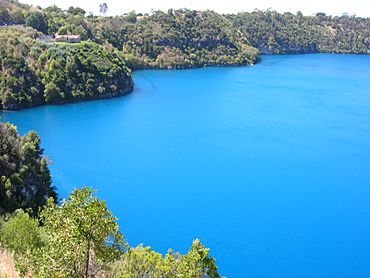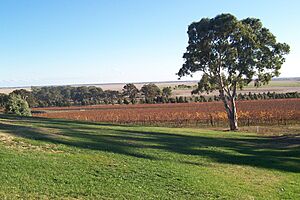Limestone Coast facts for kids
Quick facts for kids Limestone CoastSouth Australia |
|
|---|---|

Blue Lake, Mount Gambier
|
|
| Population | 64,585 (2006 ABS data) |
| LGA(s) | City of Mount Gambier District Council of Grant District Council of Robe Kingston District Council Naracoorte Lucindale Council Tatiara District Council Wattle Range Council |
| State electorate(s) |
|
| Federal Division(s) | Barker |
The Limestone Coast is a special area in the southeast of South Australia, right next to the ocean and the border with Victoria. It's known for its beautiful coastline and unique land. People use the name 'Limestone Coast' for a government region, a popular place for tourists, and even a famous area where wine is made.
| Top - 0-9 A B C D E F G H I J K L M N O P Q R S T U V W X Y Z |
What is the Limestone Coast?
The Limestone Coast is an official region in South Australia. It includes several local areas in the state's southeast. This region also covers the "coastal waters" near the shore. These waters stretch about three nautical miles (about 5.5 kilometers) out to sea. This area goes from the Victorian border in the east to the northern part of the Kingston District Council in the northwest.
Tourism in the Limestone Coast
The name 'Limestone Coast' is also used for a popular tourism area. This tourist region covers a similar part of South Australia. It includes the City of Mount Gambier and several other local councils. These include The Coorong District Council, Grant, Kingston, Robe, Tatiara, Naracoorte Lucindale, and the Wattle Range Council.
Limestone Coast Wine Zone
The 'Limestone Coast' is also a well-known wine zone. This means it's a special area where grapes are grown to make wine. This wine zone is located south of a certain line, around 36 degrees 50 minutes south latitude. This line is roughly in line with Cape Willoughby on Kangaroo Island. The zone includes several famous wine-growing regions. Some of these are Coonawarra, Mount Benson, Mount Gambier, Padthaway, Robe, and Wrattonbully.
Where is the Limestone Coast?
This region stretches from the Victorian border to the Younghusband Peninsula. European settlers started living here in the 1840s. Before that, Indigenous people had lived in the area for thousands of years. Today, the region is important for farming, growing grapes for wine (called viticulture), forestry, and tourism.
Some of the towns you can find here include Bordertown, Keith, Millicent, Mount Gambier, Penola, and Naracoorte. There are also popular coastal towns like Beachport, Kingston SE, and Robe.
Unique Landscape
Much of the Limestone Coast is quite flat and low to the ground. Millions of years ago, this area was actually covered by the sea. The land has rows of low sandhills that run parallel to the coast. These sandhills formed when the coastline was at different levels over time.
Before European settlement, many areas between the sandhills were swamps. These swamps were fed by streams and often flooded. To manage the water, a huge network of drains was built. These drains are about 1450 kilometers long and help channel water away to the ocean.
However, important wetland areas still remain. These include lakes and lagoons like the southern part of the Coorong National Park and Bool Lagoon. The Limestone Coast also has higher areas, including the volcanic craters of Mount Gambier.
The climate here is a Mediterranean climate. This means it's cool and moist, with wet winters.
History of the Limestone Coast
The name 'Limestone Coast' comes from the deep layers of limestone found here. This limestone was formed from ancient coral and other sea creatures. The limestone in the Naracoorte Caves is very special. It contains Australia's largest collection of fossils. Because of its importance, the Naracoorte Caves are a World Heritage site.
Wildlife and Nature
Plants of the Limestone Coast
The natural plant life here used to be mostly woodlands. These woodlands were filled with River Red gum trees and other types of eucalyptus trees.
Animals of the Limestone Coast
The Limestone Coast is rich in wildlife, even though few species are found only here. You can find many marsupials, like possums, Cercartetus pygmy possums, and Petaurus Gliding possums. Many of these animals don't live further west than this region.
Some unique reptiles live here, such as the striped legless lizard (Delma impar). There are also special invertebrates, like a type of cave cricket that lives only in this area. The Naracoorte caves are home to the common bent-wing bat.
The lakes and lagoons are very important for waterbirds. You can see birds like black swans, grey teals, and Pacific black ducks. The critically endangered orange-bellied parrot (Neophema chrysogaster) spends its winters here. Many other birds also visit, including the red-necked stint (Calidris ruficollis), sharp-tailed sandpiper (Calidris acuminata), and curlew sandpiper (Calidris ferruginea).
Sadly, most of the original natural areas have been cleared for farming. Only small parts remain, especially in wetland areas. The largest protected areas are Coorong National Park and Canunda National Park. Because of this, most native wildlife has disappeared or their numbers have greatly reduced. Animals brought in by humans are also a constant threat to the remaining wildlife.



